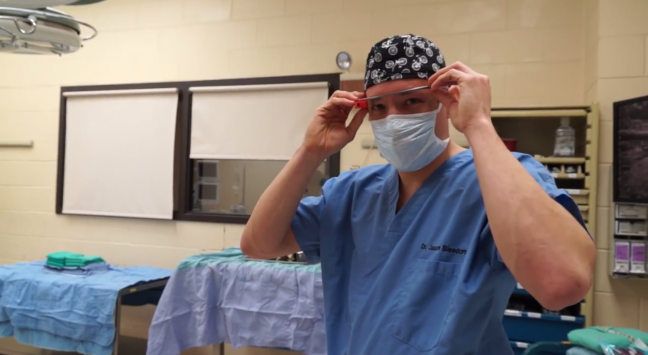In an effort to find a method to record surgical videos from a first person point of view, University of Wisconsin’s School of Veterinary Medicine is one of the first schools to implement Google Glass technology.
Last semester, Tyler Gregory, an instructional designer at the School of Veterinary Medicine, was approached by several clinical professors to assist them in recording surgical videos from a first person point of view, which gave him the idea to use Google Glass. Google Glass is a wearable, voice-controlled device that resembles a pair of reading glasses and displays information directly in the user’s field of vision.
Clinical Assistant Professor, Jason Bleedorn, began recording his surgeries using Google Glass technologies earlier this year.
“The genesis was mainly to try to capture the surgeon’s perspective for teaching students, residents and other trainees,” Bleedorn said.
In the past, Bleedorn said they had various pictures and videos from cases taken by a person leaning over his shoulder, or even more cumbersome, he would have to step back, allow someone to take a picture, then return to his surgical procedure.
Bleedorn said he wanted something that he would be able to control himself and allow him to get genuine footage during his procedures.
Bleedorn is currently working on constructing an online learning module that will allow students to follow every stage of his work with a patient from initial examination to surgery, Gregory said. The process involves compiling photo, video and Google Glass footage and converting them to teachable resources, he said.
Both Bleedorn and Gregory said they are optimistic about ways this technology can be used in a surgical setting. They said they see potential in the technology for use ranging from filming video for student instruction to using it as a direct part of the treatment by displaying X-ray images on its screen during surgery, or even as a way to broadcast real-time footage to locations outside of the operating room.
Bleedorn works specifically with small animals and said when he operates only about two or three residents can be scrubbed in at a time. The only way students can view the surgery as it happens is through live-streaming footage through a camera mounted in the ceiling, he said.
Despite his initial apprehensions, Google Glass captures wide-view, high-definition footage rather than narrowly focused, low quality video, Bleedorn said. Being able to broadcast the footage he captures from his own perspective would provide a better service to his students, he said.
However, with every new form of technology, the early phases include rapid software updates and bug fixes and Bleedorn and Gregory said the technology is promising, but has some flaws.
“There’s still some fine-tuning involving limitations with the current software. You can only record a short segment of video,” Bleedorn said.
In a surgical setting, sterilization is a crucial requirement for safe practice, Bleedorn said. Right now, Google Glass is programmed to turn off after a short period of time to preserve battery, which is not ideal in surgeries that are ongoing for up to several hours, he said.
Gregory said he has already sent requests to programmers to attend to these issues and believes upcoming software updates will resolve them.
Bleedorn and Gregory said they could see this technology benefiting complementary programs at the med school or even programs or research projects in the school of engineering.
“One of the big draws to me to veterinary school and specifically Wisconsin was to be on that forefront and be moving things forward … I think we have a service to the animals to provide a better quality of care and new techniques,” Bleedorn said in a video published on the University of Wisconsin School of Veterinary Medicine Youtube channel.


